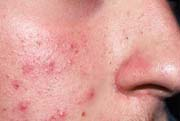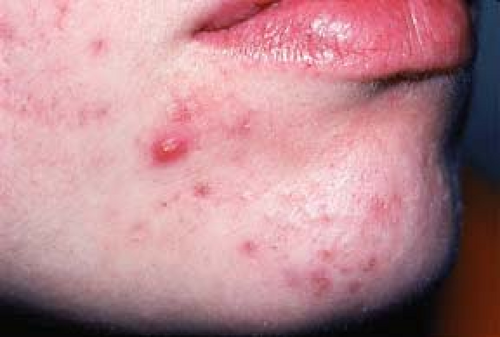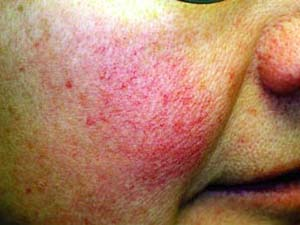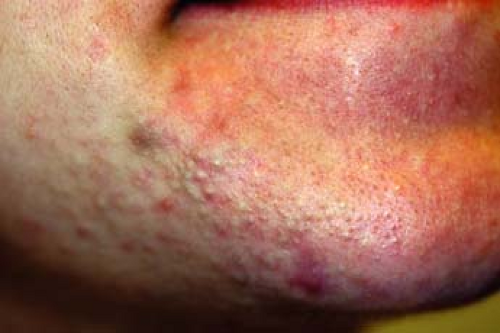Acne and Related Disorders
Jennifer Villaseñor
Daniela Kroshinsky
The chapter is divided into five sections: acne vulgaris, acne rosacea, hidradenitis suppurativa and the follicular occlusion tetrad, perioral dermatitis, and acne keloidalis. Each section contains a discussion of the clinical features, current and potential treatment alternatives, the clinical course, and prognosis for each disorder.
 |
A 15-year-old boy presents with pleomorphic lesions on the central face consisting of papules, pustules, and open comedones (Fig. 6-1). These began following puberty and have become progressively worse, leaving scars and red macules/patches on his face. What is the most likely diagnosis?
Acne Vulgaris
Background
Arguably the most common cutaneous disorder, acne vulgaris is a self-limited inflammatory reaction involving the pilosebaceous unit that often presents among adolescents. Lesions are often pleomorphic and include comedones, papules, pustules, and nodules with a range in severity of disease. Although most cases are self-limiting, a significant number of patients present with psychiatric comorbidity, especially as a result of the permanent sequelae of acne vulgaris. In rare cases, mortality due to suicide has been associated with patients with severe cases of acne vulgaris. Treatment of acne vulgaris has been associated with significant improvement of self-esteem. Effective treatment is, therefore, essential for both the resolution of acne vulgaris and remediation of associated psychiatric comorbidity.
Key Features
Follicular epidermal hyperproliferation and excess sebum production lead to follicular clogging and inflammation.
Characteristic lesions are comedones.
Common findings are comedones, papules, pustules, nodules on face, chest, and back.
Treatment includes combinations of oral and topical antimicrobials, retinoids, and hormonal agents.
Epidemiology
The impact of acne vulgaris encompasses a large proportion of the patient population, accounting for over 10% of all patient encounters and over 4.8 million visits per year. In the majority of cases, acne vulgaris becomes a significant problem after the onset of puberty and is thought to be an early manifestation of puberty. Following puberty, the incidence steadily declines with age. Many cases of acne persist beyond adolescence, particularly in women. Genetics is likely to influence the occurrence of acne vulgaris as there is often a familial association observed in many cases.
Pathogenesis
Acne vulgaris evolves through a series of events that include follicular keratinocyte hyperproliferation resulting in microcomedo formation, excess
sebum production, inflammation, and the presence and activity of Propionibacterium acnes. Keratinocyte hyperproliferation due to increased proliferation and decreased desquamation of keratinocytes lining the follicular orifice within the pilosebaceous unit is the earliest event. Increased cohesion between proliferative keratinocytes results in the formation of a plug within the follicular ostium and downstream concretions of keratin, sebum, and bacteria that eventually lead to the dilation of the upper hair follicle and microcomedo formation. Androgen stimulation via the production of dihydrotestosterone (DHT) is thought to play an important role in the formation of acne. Follicular keratinocytes convert dehydroepiandrosterone sulfate (DHEAS) to DHT. Increased production of DHT is thought to play a role in keratinocyte proliferation.
sebum production, inflammation, and the presence and activity of Propionibacterium acnes. Keratinocyte hyperproliferation due to increased proliferation and decreased desquamation of keratinocytes lining the follicular orifice within the pilosebaceous unit is the earliest event. Increased cohesion between proliferative keratinocytes results in the formation of a plug within the follicular ostium and downstream concretions of keratin, sebum, and bacteria that eventually lead to the dilation of the upper hair follicle and microcomedo formation. Androgen stimulation via the production of dihydrotestosterone (DHT) is thought to play an important role in the formation of acne. Follicular keratinocytes convert dehydroepiandrosterone sulfate (DHEAS) to DHT. Increased production of DHT is thought to play a role in keratinocyte proliferation.
With the onset of puberty, androgen hormones bind and influence sebocyte activity, resulting in enlargement of sebaceous glands and increased sebum production. This provides a rich source of fatty acids for Propionibacterium acnes, an anaerobic gram-positive diphtheroid that is a normal component found in the sebaceous follicle, and results in the increased proliferation, clumping, and colonization of P. acnes. Proliferation of P. acnes and increased keratin and sebum production lead to enlargement of the microcomedo, eventually resulting in follicular wall rupture and extrusion of its contents into the dermis, triggering a brisk inflammatory response. The presence of P. acnes is an important trigger for inflammatory response.
Clinical Presentation
The onset of acne typically occurs gradually after the onset of puberty. Acne vulgaris usually presents as an isolated cutaneous disease; abrupt onset is concerning for hormonal dysregulation including hyperandrogenism, especially in the setting of a female presenting with associated hirsutism and irregular menstrual periods. The presence of morphologically homogenous acneiform lesions should also prompt further investigation for the use of medications such as anabolic steroids, corticotropin, corticosteroids, isoniazid, vitamin B complexes, phenytoin, and lithium.
The typical lesions of acne vulgaris consist of pleomorphic lesions found on the areas of the body with the highest concentration of sebaceous glands including the face, chest, shoulders, and back. Lesions are either noninflammatory or inflammatory in nature (Fig. 6-1). Noninflammatory lesions include closed and open comedones (Fig. 6-2). The closed comedone, or whitehead, is usually a small, approximately 1-mm papule with no follicular opening or erythema. Open comedones, or blackheads, are flat or slightly raised, dome-shaped papules with a dilated follicular opening containing an inspissated core of shed keratin. Melanin deposition and lipid oxidation of the debris cause the black coloration found within open comedones. Inflammatory lesions include a range of lesions including erythematous papules, pustules, and nodules (Fig. 6-3). Scarring is a consequence of both noninflammatory and inflammatory acne.
 Figure 6-3 Inflammatory acne. From Goodheart HP. Goodheart’s Photoguide to Common Skin Disorders, 3rd ed. Philadelphia: Lippincott Williams & Wilkins, 2009. |
Table 6-1 Variants of Acne Vulgaris | ||||||||||||||||||||
|---|---|---|---|---|---|---|---|---|---|---|---|---|---|---|---|---|---|---|---|---|
|
Acne vulgaris is classified according to the number and types of lesions and whether scarring is present (Table 6-1). Mild acne is characterized by a predominance of comedones and occasional small, inflamed papules or pustules. Comedones, papules, and pustules are more prevalent and involve the face, back, chest, and shoulders in those with moderate acne. Additionally, mild scarring and occasional cysts and nodules are often present. Severe acne is characterized by the predominance of large cysts on the face, neck, and upper trunk with the presence of severe scarring.
Diagnosis
Differential Diagnosis
Acne vulgaris is often clinically apparent and distinguished by the presence of pleomorphic lesions including comedones. The presence of comedones is what distinguishes acne vulgaris from other cutaneous disorders. The most common acne mimics are rosacea, perioral dermatitis, and folliculitis. Rosacea and perioral dermatitis are part of the differential diagnosis of inflammatory acne.
Diagnostic Methods
Acne vulgaris is usually diagnosed clinically by the presence of a pleomorphic collection of lesions including papules and pustules. The presence of comedones is required for the clinical diagnosis of acne vulgaris. In general, the diagnosis of acne vulgaris does not require laboratory testing. However, a thorough evaluation of a patient presenting with acne should include a complete history to rule out a systemic etiology of disease. Rapid onset of acne associated with virilization should prompt laboratory testing of hormonal levels and imaging studies to rule out an underlying adrenal or ovarian tumor. Elevated serum androgens are found in patients with severe cystic acne and in association with endocrine abnormalities or neoplastic processes. The majority of patients with acne have normal levels of serum androgens. Additionally, a complete medication list should be obtained to rule out medication-induced acne. Physical examination should focus on the type and location of lesions, scarring, keloids, and postinflammatory pigmentary changes.
Therapy
Treatment for acne vulgaris is guided by the severity of the acne and is aimed at correcting the altered pattern of follicular keratinization, decreasing sebaceous gland activity, decreasing the follicular bacterial population, and providing an anti-inflammatory effect. Treatment modalities include both local and systemic therapies and may include combinations of both types of therapies. Most patients with mild to moderate acne respond to benzoyl peroxide, a topical antibiotic, or a combination of both drugs. Combination therapy is especially useful for patients with acne that includes both comedonal acne and inflammatory lesions. Some suggestions for treatment regimens and therapy options are presented in Tables 6-2 and 6-3.
Table 6-2 Step-wise Suggestions for Acne Therapy | |
|---|---|
|
Table 6-3 Medications Used in Acne Therapy | ||||||||||||||||||||||||||||||||||||||||||||||||||||||
|---|---|---|---|---|---|---|---|---|---|---|---|---|---|---|---|---|---|---|---|---|---|---|---|---|---|---|---|---|---|---|---|---|---|---|---|---|---|---|---|---|---|---|---|---|---|---|---|---|---|---|---|---|---|---|
| ||||||||||||||||||||||||||||||||||||||||||||||||||||||
Referral to a dermatologist should be initiated for patients with mild to moderate acne that improves less than 50% following 6 months of treatment with topical agents and oral antibiotics. Patients with scarring acne, relapsing acne, severe and/or nodulocystic acne, or patients with associated systemic symptoms or psychological stress should also be evaluated by a dermatologist. For patients desiring/requiring therapy with isotretinoin, referral to an IPLEDGE registered provider is necessary.
Scarring acne should be aggressively treated. If there is no response to conservative therapy, consider referral for systemic isotretinoin.
Women with virilization should be evaluated for hormonal dysfunction.
Ensure female patients are not pregnant before initiating topical or systemic retinoids.
One of the most effective therapies for acne vulgaris is oral isotretinoin. This medication is Food and Drug Administration (FDA) approved for therapy of treatment-resistant scarring nodulocystic acne. As with all retinoids, isotretinoin is teratogenic with pregnancy category X. The FDA has mandated a pregnancy prevention program for all providers desiring to prescribe isotretinoin (IPLEDGE). This requires extensive patient education and consent, monthly monitoring/pregnancy tests, two forms of birth control (or complete sexual abstinence), with safeguards at the office level and at the pharmacist. Males, and females not capable of becoming pregnant (hysterectomy or after menopause), are also enrolled in the IPLEDGE program, though the requirements are not as strict.
Course and Complications
Acne vulgaris is typically a self-limited disease with a variable course that may continue for several years up to the third and fourth decades. It may include periods of remission. The overall prognosis is generally favorable; however, treatment should be initiated early during the course of the disease to prevent
the permanent sequelae of the disease. Some of the complications of acne vulgaris may be as benign as transient macular erythema to more persistent or permanent sequelae such as postinflammatory hyperpigmentation or scarring. Scarring acne should be treated aggressively. Additionally, it is estimated that up to 50% of patients with acne have psychiatric comorbidities and experience similar levels of social, psychological, and emotional impairments as those suffering from asthma or epilepsy.
the permanent sequelae of the disease. Some of the complications of acne vulgaris may be as benign as transient macular erythema to more persistent or permanent sequelae such as postinflammatory hyperpigmentation or scarring. Scarring acne should be treated aggressively. Additionally, it is estimated that up to 50% of patients with acne have psychiatric comorbidities and experience similar levels of social, psychological, and emotional impairments as those suffering from asthma or epilepsy.
ICD9 Codes
| 706.1 | Other acne |
 |
A 35-year-old white female presents with complaints of persistent erythema of her cheeks with papules and pustules resembling acne (Fig. 6-4). She reports a long history of sensitivity to various facial lotions and astringents. Upon closer inspection, there are telangiectasias present without evidence for comedones. She reports flushing/blushing with alcohol consumption and hot/spicy foods. Her mother has had similar eruptions. What is the most likely diagnosis? What test can be done to confirm the diagnosis?
Acne Rosacea
Background
Rosacea is a chronic acneiform disorder of unknown etiology affecting approximately 14 million adults and found most frequently among the white population. The most characteristic feature of rosacea is persistent erythema of the central face involving the nose, cheeks, chin, and forehead. Primary clinical features include flushing/transient erythema, nontransient erythema, papules, pustules, and telangiectasias. Secondary features include facial burning or stinging, edema, plaques, dryness, phyma, peripheral flushing, and ocular manifestations. The presentation of rosacea is quite variable and four distinct sub-types have been described.
Key Features
Rosacea presents with persistent erythema of the central face: nose, cheeks, chin, and forehead.
Primary clinical features include flushing (transient erythema), papules, pustules, telangiectasias.
Secondary features include facial burning or stinging, edema, plaques, dryness, phyma, peripheral flushing, and ocular manifestations.
Hot or cold temperature, sunlight, alcohol, exercise, spicy foods, emotional stress, topical irritants, and medications are triggers of rosacea.
Prevention of rosacea involves sun protection and avoidance of triggers of rosacea.
Treat using ultraviolet (UV) protection, topical and oral antibiotics, topical retinoids, intense pulsed light, vascular laser modalities.
Pathogenesis
The etiology and pathogenesis of acne rosacea is still unclear. However, factors affecting facial vascular reactivity, changes in dermal connective tissue structure or composition, matrix composition, pilosebaceous structure, microbial colonization, or a combination of these factors have been attributed to the development of rosacea.
Clinical Presentation
Rosacea is a chronic disorder characterized by periods of exacerbation and remission that can be triggered or worsened by various stimuli including hot or spicy foods, alcohol, and temperature changes. Facial erythema, particularly on the nose and cheeks, and telangiectasias are typical presenting symptoms of rosacea. Severe sebaceous gland growth with associated papules, pustules, cysts, and nodules may also be present and appear very similar to the lesions of acne vulgaris. However, the lack of comedones distinguishes rosacea from acne vulgaris. Ocular symptoms associated with the typical skin lesions of rosacea may develop and are characterized by foreign body sensation and burning, telangiectasia and irregularity of lid margins, meibomian gland dysfunction, keratitis, conjunctivitis, and episcleritis. Another characteristic feature associated with rosacea is rhinophyma, which results from hyperplasia of the soft tissues of the nose.
Key Features
Persistent facial erythema and flushing of the central portion of the face with telangiectasias, central edema, burning or stinging, roughness, or scaling.
Stay updated, free articles. Join our Telegram channel

Full access? Get Clinical Tree







